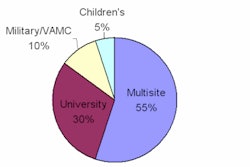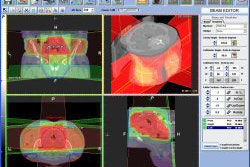Streamlining the process of delivering radiology reports -- and making them universally accessible -- doesn't guarantee that they'll be read any faster by clinicians. In fact, quite the opposite may occur if human behavior doesn't adapt to the changes imposed by adopting healthcare informatics.
Norwegian researchers spent two years tracking physician reading patterns of electronic radiology reports and found that the implementation of electronic access to reports didn't have the impact expected of the technology. The evaluation also uncovered the alarming fact that some reports weren't being read at all after a RIS and PACS were integrated with an electronic patient record (EPR), according to a study published online August 6, 2008, in European Radiology.
Akershus University Hospital, located in the Oslo suburb of Lørenskog, is one of Norway's largest hospitals. The 515-bed teaching hospital is one of four affiliated with the University of Oslo. It installed its first RIS in 1999 for use within the radiology department.
The RIS was expanded to provide hospital-wide access in 2004, in conjunction with the installation of a hospital-wide EPR. After the installation of a PACS in 2005, clinicians were able to access diagnostic images immediately and obtain preliminary and final radiology reports as soon as they were typed.
In the European Radiology study, researchers investigated how rapidly clinicians read electronic radiology reports, how well they adapted to a change of traditional routine, and factors that influenced the use of the reports.
Radiology rounds -- the traditional method
Prior to EPR/RIS/PACS integration in May 2005, the results of diagnostic tests of hospital inpatients were presented by specialist radiologists to clinicians in daily briefings held in the diagnostic imaging department. During each 90-minute session, radiologists would present findings of the examinations performed over the past 24 hours.
These early-morning radiology rounds were the venue for discussion and resolution of any discrepancies or modifications of findings. Final written reports would be prepared following the meeting, and paper copies would be delivered by 3 p.m. to inpatient wards or physician offices. The reports would be reviewed and signed by a responsible clinician and filed the same day in the patients' folders. This process had worked smoothly and effectively for years.
Going electronic -- changing the process
After Akershus University Hospital went electronic, preliminary radiology reports would be added to the patient file on the EPR as soon as they were completed by a transcriptionist. A final report would be added as soon as it was approved and signed as the final step of a double-reading protocol. The reports could be accessed by any legally authorized medical professional.
To prevent reports from being overlooked, reports of an individual patient would be added to the radiology report worklist of a specific clinician and of a specific ward in the hospital, based on hospital-defined rules. Both preliminary and final reports would be added to a worklist, but if a preliminary report had not been opened by the time a final report arrived, both would be seen only as a single worklist entry.
In theory, this was a better and more efficient process. To verify this presumption, a research team led by Dr. Petter Hurlen, one of 30 radiologists of the hospital's Center for Diagnostic Imaging and Helse Sør-Øst Health Services Research Center, launched a study that involved retrieving datasets tracking the access to one full week of examinations every four months after implementation in May 2005. The datasets contained information about image acquisition time, time of dissemination of radiology reports, modality, referring physician, patient category, and degree of urgency.
Five datasets were acquired through February 2007. A total of 10,098 individual patient reports were evaluated out of 16,470 obtained. Of the reports, 4,258 related to inpatient emergency cases, 2,185 to inpatient routine cases, and 4,555 to outpatient cases. Datasets of multiple examinations were not utilized because if multiple exams were ordered simultaneously, all reports relating to the order would be merged together with one date stamp, even if they were made available at different times.
To provide a point of comparison for pre-electronic report delivery, an arbitrary presumption was made that the results of preliminary reports were conveyed to clinicians at 8:30 a.m. and that the final report would have been read at 3:30 p.m. in the 24-hour period following the exam acquisition.
Surprising results
On average, only 42% of the preliminary reports and 88% of the final reports were opened during the evaluation period. These statistics were consistent from the first evaluation period in September 2005 to the last in February 2007.
The first dataset sampling had the highest percentage of preliminary reports read (approximately 65%), after which preliminary report access dropped to 22% and never rose to more than 43%. If a preliminary report was opened, however, 91% of the time the final report would also be read.
Other findings included the following:
- 11% of urgent emergency inpatient reports were not accessed.
- 14% of outpatient reports were not accessed.
- 15% of orthopedic surgeons did not access reports.
- 10% of all the other medical specialists and caregivers did not access reports.
- 13% of all computed radiography (CR) exam reports were never opened.
On average, urgent reports for emergency department patients and routine reports were opened in the same time frame:
Median time from availability on EPR for referring physicians to open radiology reports
|
The researchers discovered a technical glitch that slightly affected readership statistics -- 8% of all routine inpatient exam reports (estimated as a total of 35 reports) in the first four months of use never appeared on any clinician worklist.
Analysis
Because the statistics were so consistent throughout all five datasets analyzed, the researchers did not believe that any of the report access and reading patterns could be attributed to unfamiliarity with the use of an EPR.
The researchers attributed a certain percentage of unread reports to the fact that they were ordered unnecessarily by clinicians who ultimately did not need them, or by inexperienced residents. Clinicians waiting for the results of specific procedures not only opened the preliminary reports, but also opened the final report when it became available.
With direct access to the PACS for their patients' images, orthopedic specialists presumably did their own interpretations, particularly with respect to CR exams. A higher percentage of CT and ultrasound exam reports were opened by orthopedic specialists than CR exams.
The researchers attributed the failure of emergency department staff to open reports of emergency patients immediately upon availability to the fact that "some of the reports may have arrived too late to be of clinical interest, in particular in emergency cases." The researchers presumed that reports were not opened when findings were conveyed by the radiologists by telephone or in person to emergency physicians, according to Hurlen in an e-mail statement to AuntMinnie.com.
Findings related to the amount of time it took to electronically access reports were also affected by the fact that a number of clinicians preferred to bypass the worklist and access the database of the patient EPR directly. While the creation of worklists for individual clinicians of their own patients was designed to streamline the process, as well as provide a safeguard that the reports could not be overlooked in the EPR, for some clinicians this was a process that added a lot of extra work, Hurlen explained.
Clinicians who directly accessed the EPR still had to open and close the listings in their worklist. Listings of patients whose reports were opened in that manner were not automatically deleted. In the first months of implementation, both preliminary and final reports would be separately listed rather than merged together. This also added unnecessary work if a clinician opened a final report first, because the preliminary report listing could not automatically be removed. While this was corrected, it was still an irritant.
Trust in the completeness of the individual physician's worklist was undermined by the initial glitch that failed to deliver 8% of the reports. Lingering distrust of both the worklist and the EPR was believed to have played a large contributing role in a request for return to verbal consultations.
The researchers noted that "even though both images and reports were available through the EPR, many clinicians insisted that the traditional radiology rounds should be continued as before." As a result the meetings were reinstated.
"More fundamental changes in the daily routines and logistics are required to improve the quality and reduce the time of information transmission between radiologists and clinicians," the researchers stated in the article.
The group's research resulted in changes at the hospital that have improved the quality of the overall dialogue between radiologists and clinicians, Hurlen said. There is less emphasis by both parties on the use of formal radiology rounds. Communication refinements optimizing the use of electronic technologies are part of an ongoing process improvement initiative.
By Cynthia Keen
AuntMinnie.com staff writer
October 6, 2008
Related Reading
Critical results reporting software is promising, challenging, September 22, 2008
U.S. doctors making slow shift to digital records, June 19, 2008
Using informatics to meet communication challenges, February 7, 2008
Imaging informatics shaped by evolving role, June 7, 2007
Copyright © 2008 AuntMinnie.com



















